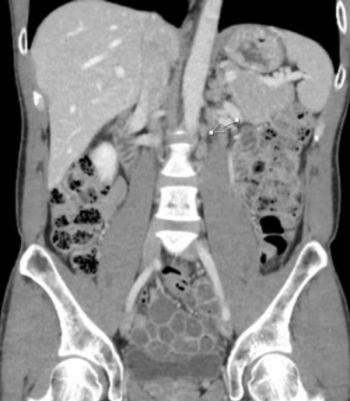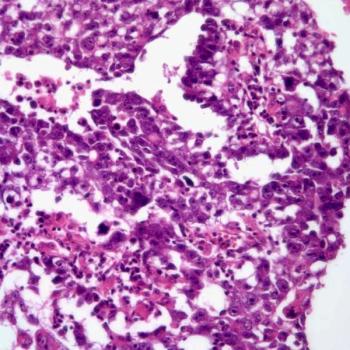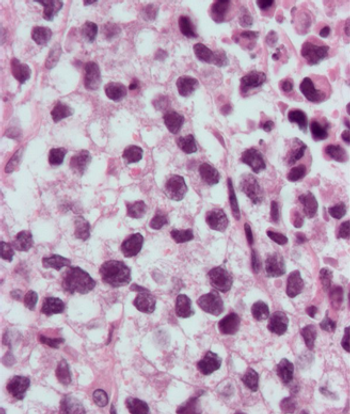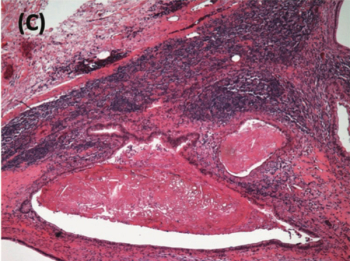
- ONCOLOGY Vol 16 No 11
- Volume 16
- Issue 11
The Lieberman/Schold Article Reviewed
Drs. Lieberman and Schold have presented a comprehensive up-to-date review of paraneoplastic syndromes affecting the nervous system. The points are all well made, but a few deserve special comment:
Drs. Lieberman and Schold have presented a comprehensiveup-to-date review of paraneoplastic syndromes affecting the nervous system. Thepoints are all well made, but a few deserve special comment:
(1) "Approximately 50% of pediatric cases [of opsoclonusmyoclonus] are paraneoplastic." Most pediatric neurologists now believethat nonparaneoplastic opsoclonus is far more common than the paraneoplasticvariety associated with neuroblastoma. It is likely that only 5% of childrenratherthan the 50% referred to in the literaturewho present to physicians withopsoclonus have neuroblastoma as the underlying cause.
(2) "Ma2 is…shared by the testis and normal brain."Curiously, Ma2, the paraneoplastic antigen associated with testicular cancer, isnot found in normal testes, whereas Ma1, associated with a variety ofnontesticular cancers, is.
(3) "Paraneoplastic peripheral neuropathy was an uncommondiagnosis." In most series, a final diagnosis of paraneoplastic peripheralneuropathy is made in about 5% of patients referred to a neurologic clinicfor polyneuropathy. However, once obvious causes (ie, diabetes, hereditary ornutritional disorders) are eliminated, paraneoplastic peripheral neuropathy is amore common diagnosis.[1]
(4) "Spinal muscular atrophy is an opportunistic viralsyndrome." A recent study has described an amyotrophic lateral sclerosis-likesyndrome in patients with acquired immunodeficiency syndrome. The neurologicdisorder responds to antiviral therapy.[2]
Treatment Dilemmas
The major question for the clinician is how to approach apatient with or without a known cancer who develops a neurologic disorder, thecause of which is not apparent during the initial diagnostic evaluation. Suchpatients fall into two categories: The first, more common group includespatients without a known cancer. The second, less common group includes patientswhose cancer was identified prior to the development of the neurologic symptoms.This group may either be under active treatment or in remission after initialtreatment.
Patients in the first group are seen initially by a familypractitioner or internist and are usually referred to a neurologist fordiagnostic evaluation. As Lieberman and Schold point out, the best approach tomanaging a paraneoplastic syndrome is to identify and treat the underlyingtumor. Therefore, an early diagnosis is important to prevent irreversiblenervous system damage. As they also indicate, however, a clinical pictureidentical to each of the paraneoplastic syndromes can occur in patients withoutcancer. The increased incidence of such disorders in cancer patients establishesa syndrome as paraneoplastic. If, after careful neurologic evaluation, aparaneoplastic syndrome is a significant clinical consideration, the physicianshould measure the serum for paraneoplastic antibodies.
Antibody Considerations
The nature of the antibodies searched for would depend on theclinical syndromes. For example, if the patient presents with a sensorimotorperipheral neuropathy, especially one that is demyelinating, immunoglobulin G orM antibodies against peripheral nerve tissue may suggest an underlying myelomaor lymphoma. If the disorder is a pure sensory neuropathy, and especially ifthere is evidence of central nervous system (CNS) dysfunction, serum should beassayed for anti-Hu antibodies. However, particularly with CNS paraneoplasticsyndromes, the overlap among antibody-positive clinical syndromes warrants amuch broader screen than simply looking for a single paraneoplastic antibody.Antibodies can be identified by immunohistochemistry, Western blotting, or,preferably, both.[3]
If examination of the serum identifies a known paraneoplasticantibody, the physician can narrow the search for the underlying tumor. Forexample, a woman with a cerebellar syndrome and anti-Yo antibody in the serumhas an almost 100% probability of having cancer, and a greater than 90%likelihood that the tumor will be either in the breast or the genital system(usually the ovary). A patient with a sensory neuropathy or encephalomyelitisand an anti-Hu antibody in the serum, likewise, has an almost 100% likelihood ofhaving cancer, and a greater than 90% likelihood that it is small-cell lungcancer.
That said, the physician must recognize that all antibodies arenot as specific as the two indicated above. For example, although cancer is theunderlying cause of a Lambert-Eaton myasthenic syndrome in only two-thirds ofsuch patients, virtually all patients harbor anti-P/Q voltage-gated calciumchannels in their serum.
Further Evaluation
The physician must recognize that not all patients withparaneoplastic syndromes are antibody-positive, and that not all antibodies havebeen identified and characterized. Thus, if a strong suspicion remains evenafter serum testing fails to reveal a paraneoplastic antibody, the physician maystill want to undertake a search for an underlying cancer. That search generallyincludes a careful physical examination, measurement of serum cancer markers,and computed tomography of the chest, abdomen, and pelvis. Recent evidencesuggests that total-body positron-emission tomography using18-fluorodeoxyglucose may be a rapid and sensitive approach to identifying anoccult cancer.[4]
Examination of the cerebrospinal fluid (CSF) is also helpful.Most CNS paraneoplastic syndromes, particularly early in their course, areaccompanied by a modest pleocytosis (20 to 100 lymphocytes) and elevatedimmunoglobulins. Paraneoplastic antibodies found in the CSF are always presentin the serum, albeit at a lower titer. Thus, CSF examination for antibodies isunnecessary.
For the patient with a known cancer, the problem isdistinguishing paraneoplastic involvement of the nervous system from other morecommon complications of cancer such as nervous system metastases, ornonmetastatic syndromes, including opportunistic infections, lesions related tohyper- or hypocoagulability, nutritional and metabolic disorders, and the sideeffects of therapy. Imaging and, when appropriate, spinal fluid evaluation,generally exclude metastatic disease.
As in patients without a known cancer, the presence ofparaneoplastic antibodies helps to establish a positive diagnosis, but the otherabnormalities discussed above must always be considered. In the patient whosecancer has been remote and is considered in remission, development of theneurologic syndrome may presage relapse of the disease, and a search forrecurrence is warranted.
Conclusions
As Lieberman and Schold indicate, treatment depends on thesyndrome. Certain syndromes, such as Lambert-Eaton myasthenic syndrome, respondboth to treatment of the underlying tumor and to immunosuppression. Others arepoorly responsive to either. Nevertheless, vigorous treatment of the underlyingcancer is certainly indicated.
Anticancer therapy may help stabilize or ameliorate neurologicsymptoms. Although immunosuppression has not proven efficacious in most largeseries, individual case reports suggest the possibility that an occasionalpatient may respond to immunosuppression. Intravenous immunoglobulin is the mostcommonly used immunosuppressive therapy.
References:
1. Verghese J, Bieri PL, Gellido C, et al: Peripheral neuropathyin young-old and old-old patients. Muscle Nerve 24:1476-1481, 2001.
2. MacGowan DJ, Scelsa SN, Waldron M: An ALS-like syndrome withnew HIV infection and complete response to antiretroviral therapy. Neurology57:1094-1097, 2001.
3. Dalmau J, Posner JB: Neurologic paraneoplastic antibodies(anti-Yo; anti-Hu; anti-Ri): The case for a nomenclature based on antibody andantigen specificity. Neurology 44:2241-2246, 1994.
4. Rees JH, Hain SF, Johnson MR, et al: The role of[18F]fluoro-2-deoxyglucose-PET scanning in the diagnosis of paraneoplasticneurological disorders. Brain 124:2223-2231, 2001.
Articles in this issue
about 23 years ago
Study Reveals Benefits of Drug Pump for Cancer Painabout 23 years ago
Three Themes to Guide von Eschenbach as NCI Directorabout 23 years ago
Update: AIDS United States, 2000about 23 years ago
Rituxan Delays Disease Progression in Indolent Non- Hodgkin’s Lymphomaabout 23 years ago
Radiation Therapy Alone Can Be Used to Treat Rectal Cancerabout 23 years ago
Oncologic Imaging, Second EditionNewsletter
Stay up to date on recent advances in the multidisciplinary approach to cancer.

















































































